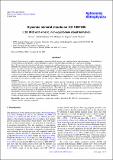Files in this item
Dynamic mineral clouds on HD 189733b : I. 3D RHD with kinetic, non-equilibrium cloud formation
Item metadata
| dc.contributor.author | Lee, G. | |
| dc.contributor.author | Dobbs-Dixon, I. | |
| dc.contributor.author | Helling, Ch. | |
| dc.contributor.author | Bognar, K. | |
| dc.contributor.author | Woitke, P. | |
| dc.date.accessioned | 2016-10-25T10:30:33Z | |
| dc.date.available | 2016-10-25T10:30:33Z | |
| dc.date.issued | 2016-10-10 | |
| dc.identifier | 246880421 | |
| dc.identifier | e6c086e7-75bf-4e53-a7dd-acdfb578c6fc | |
| dc.identifier | 84991790347 | |
| dc.identifier.citation | Lee , G , Dobbs-Dixon , I , Helling , C , Bognar , K & Woitke , P 2016 , ' Dynamic mineral clouds on HD 189733b : I. 3D RHD with kinetic, non-equilibrium cloud formation ' , Astronomy & Astrophysics , vol. 594 , A48 . https://doi.org/10.1051/0004-6361/201628606 | en |
| dc.identifier.issn | 0004-6361 | |
| dc.identifier.uri | https://hdl.handle.net/10023/9698 | |
| dc.description | Funding: European community under the FP7 ERC starting grant 257431 (G.L., Ch. H.). | en |
| dc.description.abstract | Context. Observations of exoplanet atmospheres have revealed the presence of cloud particles in their atmospheres. 3D modelling of cloud formation in atmospheres of extrasolar planets coupled to the atmospheric dynamics has long been a challenge. Aims. We investigate the thermo-hydrodynamic properties of cloud formation processes in the atmospheres of hot Jupiter exoplanets. Methods. We simulate the dynamic atmosphere of HD 189733b with a 3D model that couples 3D radiative-hydrodynamics with a kinetic, microphysical mineral cloud formation module designed for RHD/GCM exoplanet atmosphere simulations. Our simulation includes the feedback effects of cloud advection and settling, gas phase element advection and depletion/replenishment and the radiative effects of cloud opacity. We model the cloud particles as a mix of mineral materials which change in size and composition as they travel through atmospheric thermo-chemical environments. All local cloud properties such as number density, grain size and material composition are time-dependently calculated. Gas phase element depletion as a result of cloud formation is included in the model. In situ effective medium theory and Mie theory is applied to calculate the wavelength dependent opacity of the cloud component. Results. We present a 3D cloud structure of a chemically complex, gaseous atmosphere of the hot Jupiter HD 189733b. Mean cloud particle sizes are typically sub-micron (0.01−0.5 μm) at pressures less than 1 bar with hotter equatorial regions containing the smallest grains. Denser cloud structures occur near terminator regions and deeper (~1 bar) atmospheric layers. Silicate materials such as MgSiO3[s] are found to be abundant at mid-high latitudes, while TiO2[s] and SiO2[s] dominate the equatorial regions. Elements involved in the cloud formation can be depleted by several orders of magnitude. Conclusions. The interplay between radiative-hydrodynamics and cloud kinetics leads to an inhomogeneous, wavelength dependent opacity cloud structure with properties differing in longitude, latitude and depth. This suggests that transit spectroscopy would sample a variety of cloud particles properties (sizes, composition, densities). | |
| dc.format.extent | 24 | |
| dc.format.extent | 68861606 | |
| dc.language.iso | eng | |
| dc.relation.ispartof | Astronomy & Astrophysics | en |
| dc.subject | Planets and satellites: atmospheres | en |
| dc.subject | Planets and satellites: individual: HD 189733b | en |
| dc.subject | Hydrodynamics | en |
| dc.subject | Radiative transfer | en |
| dc.subject | Methods: numerical | en |
| dc.subject | QB Astronomy | en |
| dc.subject | QC Physics | en |
| dc.subject | NDAS | en |
| dc.subject | BDC | en |
| dc.subject | R2C | en |
| dc.subject.lcc | QB | en |
| dc.subject.lcc | QC | en |
| dc.title | Dynamic mineral clouds on HD 189733b : I. 3D RHD with kinetic, non-equilibrium cloud formation | en |
| dc.type | Journal article | en |
| dc.contributor.sponsor | European Research Council | en |
| dc.contributor.institution | University of St Andrews. School of Physics and Astronomy | en |
| dc.identifier.doi | https://doi.org/10.1051/0004-6361/201628606 | |
| dc.description.status | Peer reviewed | en |
| dc.identifier.url | https://arxiv.org/abs/1603.09098 | en |
| dc.identifier.grantnumber | 257431 257431 | en |
This item appears in the following Collection(s)
Items in the St Andrews Research Repository are protected by copyright, with all rights reserved, unless otherwise indicated.

